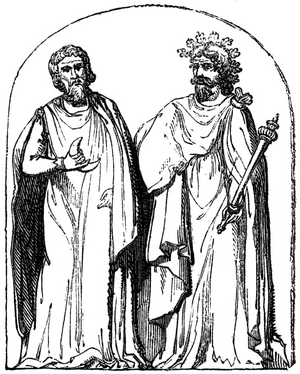Druid facts for kids

A druid was a member of the priestly and learned class in the pre-Christian, ancient Celtic societies.
These societies existed through much of Western Europe, Britain and Ireland, until the Roman government took over and, later, Christianity arrived. Druids were part of the cultures of the tribal peoples who were called "Keltoi" (Κέλτοι) or "Keltai" (Κέλται) and "Galatai" (Γαλάται) by the Greeks and "Celtae" and "Galli" by the Romans. In the communities they served, druids combined the duties of priest, arbitrator, healer, scholar, and magistrate. Both men and women served as druids, although there is no early proof for female druids, or druidesses.
Druids left no written accounts. Historians believe that Druids were literate, but were prevented by doctrine from recording their knowledge in written form. Their beliefs and practices are attested in some detail by their contemporaries from other cultures, such as the Romans and the Greeks.
The earliest known references to the druids date to the 4th century BC. The oldest detailed description comes from Julius Caesar's Commentarii de Bello Gallico (50s BCE). They were described by other Roman writers such as Cicero, Tacitus, and Pliny the Elder. Following the Roman invasion of Gaul, the druid orders were suppressed by the Roman government under the 1st-century CE emperors Tiberius and Claudius, and had disappeared from the written record by the 2nd century.
History
The Greco-Roman and the Irish sources agree that the druids played an important part in pagan Celtic society. In his description, Julius Caesar wrote that they were responsible for organizing worship and sacrifices, divination, and judicial procedure in Gallic, British, and Irish societies. He mentioned that they were exempt from military service and from paying taxes, and had the power to excommunicate people from religious festivals, making them social outcasts. Two other classical writers, Diodorus Siculus and Strabo, stated that the druids were held in such respect that if they intervened between two armies they could stop the battle.
Diodorus writes of the Druids that they were "philosophers" and "men learned in religious affairs" who are honored.
Pomponius Mela was the first author to say that the druids' instruction was secret and took place in caves and forests.
Druidic lore consisted of a large number of verses learned by heart, and Caesar remarked that it could take up to twenty years to complete the course of study. All instruction was communicated orally, but for ordinary purposes, Caesar reports, the Gauls had a written language in which they used Greek letters. In this he probably draws on earlier writers; by the time of Caesar, Gaulish inscriptions had moved from Greek script to Latin script.
Caesar believed that this practice of oral transmission of knowledge and opposition to recording their ideas had dual motivations: wanting to keep druidic knowledge from becoming common, and improving the druids' faculties of memory.
Druids in mythology
Druids play a prominent role in Irish folklore, generally serving lords and kings as high ranking priest-counselors with the gift of prophecy and other assorted mystical abilities – the best example of these possibly being Cathbad. The chief druid in the court of King Conchobar mac Nessa of Ulster, Cathbad features in several tales, most of which detail his ability to foretell the future. In the tale of Deirdre of the Sorrows – the foremost tragic heroine of the Ulster Cycle – the druid prophesied before the court of Conchobar that Deirdre would grow up to be very beautiful, and that kings and lords would go to war over her, much blood would be shed because of her, and Ulster's three greatest warriors would be forced into exile for her sake. This prophecy, ignored by the king, came true.
The greatest of these mythological druids was Amergin Glúingel, a bard and judge for the Milesians featured in the Mythological Cycle. The Milesians were seeking to overrun the Tuatha Dé Danann and win the land of Ireland but, as they approached, the druids of the Tuatha Dé Danann raised a magical storm to bar their ships from making landfall. Thus Amergin called upon the spirit of Ireland itself, chanting a powerful incantation that has come to be known as The Song of Amergin and, eventually (after successfully making landfall), aiding and dividing the land between his royal brothers in the conquest of Ireland, earning the title Chief Ollam of Ireland.
Other such mythological druids were Tadg mac Nuadat of the Fenian Cycle, and Mug Ruith, a powerful blind druid of Munster.
Images for kids
-
Julius Caesar, the Roman general and later dictator, who wrote the most important source for the Druids in Britain
-
Headdress of the "Deal Warrior", possibly worn by druids, 200–150 BCE, British Museum
See also
 In Spanish: Druida para niños
In Spanish: Druida para niños





